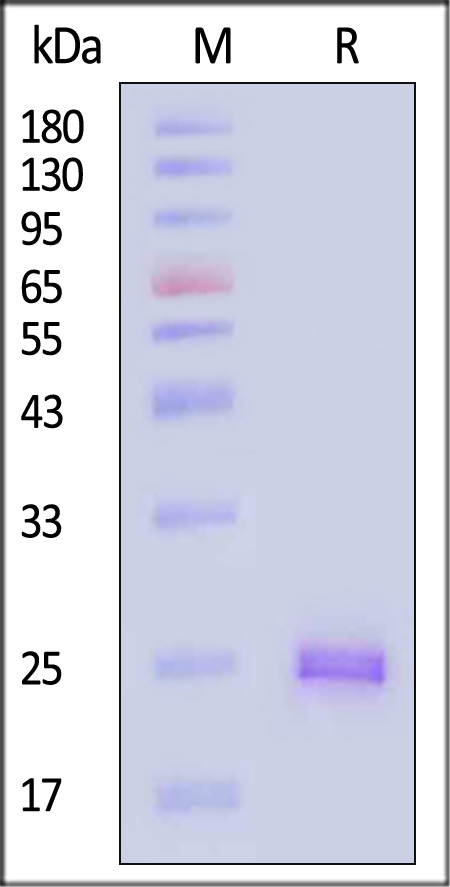分子别名(Synonym)
HLA-G, HLA class I histocompatibility antigen, alpha chain G, HLAG, HLA-6.0
表达区间及表达系统(Source)
Human HLA-G protein, His Tag (HLG-H51H3) is expressed from E. coli cells. It contains AA Gly 25 - Ala 206 (Accession # P17693-1).
Predicted N-terminus: Met
Request for sequence
蛋白结构(Molecular Characterization)

This protein carries a polyhistidine tag at the C-terminus.
The protein has a calculated MW of 23 kDa. The protein migrates as 23-26 kDa when calibrated against Star Ribbon Pre-stained Protein Marker under reducing (R) condition (SDS-PAGE).
内毒素(Endotoxin)
Less than 1.0 EU per μg by the LAL method.
纯度(Purity)
>90% as determined by SDS-PAGE.
制剂(Formulation)
Lyophilized from 0.22 μm filtered solution in PBS, 0.5 M Arginine, 0.5 M NaCl, pH 7.3 with trehalose as protectant.
Contact us for customized product form or formulation.
重构方法(Reconstitution)
Please see Certificate of Analysis for specific instructions.
For best performance, we strongly recommend you to follow the reconstitution protocol provided in the CoA.
存储(Storage)
For long term storage, the product should be stored at lyophilized state at -20°C or lower.
Please avoid repeated freeze-thaw cycles.
This product is stable after storage at:
- -20°C to -70°C for 12 months in lyophilized state;
- -70°C for 3 months under sterile conditions after reconstitution.
质量管理控制体系(QMS)
电泳(SDS-PAGE)

Human HLA-G protein, His Tag on SDS-PAGE under reducing (R) condition. The gel was stained with Coomassie Blue. The purity of the protein is greater than 90% (With Star Ribbon Pre-stained Protein Marker).
活性(Bioactivity)-ELISA

Immobilized Human HLA-G protein, His Tag (Cat. No. HLG-H51H3) at 5 μg/mL (100 μL/well) can bind Human KIR2DL4, Fc Tag (Cat. No. KI4-H5255) with a linear range of 1.6-50 ng/mL (QC tested).
Protocol

Immobilized Human HLA-G protein, His Tag (Cat. No. HLG-H51H3) at 5 μg/mL (100 μL/well) can bind Human LILRB2, Fc Tag (Cat. No. LI2-H5253) with a linear range of 0.3-2 ng/mL (Routinely tested).
Protocol
背景(Background)
Human leukocyte antigen-G (HLA-G) is a group of closely linked genes located on the short arm of human chromosome 6. Hla-g belongs to a non-classical major histocompatibility complex. MHC class I molecules are selectively highly expressed in extravvillous trophoblast cells invading the uterine decidual membrane.The gene structure of HLA-G is similar to that of HLA-A,HLA-B and HLA-C, but the termination code appears in advance so that the intracellular segment of protein product encoded by HLA-G is only 6 amino acids, which is significantly shorter than the 30 amino acids of classical HLA classI antigen. The Human HLA-G & B2M & RIIPRHLQL Complex Protein is a complex of HLA-G of the MHC Class I, B2M and RMFPNAPYL peptide.























































 膜杰作
膜杰作 Star Staining
Star Staining
















